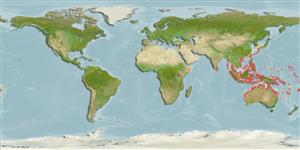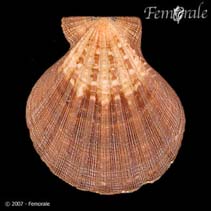Decatopecten radula (Linnaeus, 1758)
Flatribbed scallop| Native range | All suitable habitat | Point map | Year 2050 |

|
| This map was computer-generated and has not yet been reviewed. |
| Decatopecten radula AquaMaps Data sources: GBIF OBIS |
Classification / Names Common names | Synonyms | CoL | ITIS | WoRMS
| Pectinida | Pectinidae
Environment: milieu / climate zone / depth range / distribution range นิเวศวิทยา
; ระดับความลึก 0 - 20 m (Ref. 348). Tropical
การแพร่กระจาย ประเทศต่างๆ | พื้นที่จำแนกตาม FAO | ระบบนิเวศหลายระบบ | การปรากฏขึ้น,การเกิดขึ้น,พบ | การแนะนำ
Indo-West Pacific: from India to Melanesia; north Japan and south to Queensland and New Caledonia.
Length at first maturity / ขนาด / น้ำหนัก / Age
Maturity: Lm ? range ? - ? cm Max length : 9.5 cm SHL เพศผู้/กระเทย; (Ref. 348); common length : 7.0 cm เพศผู้/กระเทย; (Ref. 348)
Short description สัณฐานวิทยา
Shell solid, medium sized, higher than long, elongate-ovate in outline. Both valves convex, the right (lower) valve more inflated than the left (upper) valve. Ears subequal in size and shape. Right anterior ear with a slight byssal notch anteroventrally, devoid of ctenolium. Outer sculpture of about 10 or 11 rounded radial folds (9 to 13) on each valve, with numerous, much smaller, secondary radial riblets that are set with densely and finely imbricated transverse scales, giving a rather strongly scabrous aspect. Surface of ears with distinct radial ridges (more developed on right anterior ear). Hinge line quite long, about 2/3 of shell length, with shallow marginal ridges. Interior of valves shiny, with a flattened radial sculpture corresponding with the outer folds. Colour: outside of shell off-white to interior satin white, with dark brown on the hinge line.
Attached to rock, coral and other hard objects. Common on coarse sand in coral reef areas. Intertidal and shallow subtidal waters (Ref. 348).
Life cycle and mating behavior วัยเจริญพันธุ์ | การสืบพันธุ์ | การวางไข่ | เซลสืบพันธ์ของเพศเมีย(ไข่) | ความดกของไข่ | ตัวอ่อน
Members of the class Bivalvia are mostly gonochoric, some are protandric hermaphrodites. Life cycle: Embryos develop into free-swimming trocophore larvae, succeeded by the bivalve veliger, resembling a miniature clam.
Main reference
อ้างอิง | ผู้ประสานงาน | ผู้ร่วมมือ
Poutiers, J.M. 1998. (Ref. 348)
IUCN Red List Status (Ref. 130435)
CITES status (Ref. 108899)
Not Evaluated
CMS (Ref. 116361)
Not Evaluated
Threat to humans
Harmless
Human uses
| FishSource |
เครื่องมือ
ข้อมูลเพิ่มเติม
ประเทศต่างๆ
พื้นที่จำแนกตาม FAO
ระบบนิเวศหลายระบบ
การปรากฏขึ้น,การเกิดขึ้น,พบ
การแนะนำ
Stocks
นิเวศวิทยา
อาหาร, โภชนาการ
รายการอาหาร
พื้นที่จำแนกตาม FAO
ระบบนิเวศหลายระบบ
การปรากฏขึ้น,การเกิดขึ้น,พบ
การแนะนำ
Stocks
นิเวศวิทยา
อาหาร, โภชนาการ
รายการอาหาร
ชื่อสามัญ
ชื่อพ้อง
ผู้ล่า
การสืบพันธุ์
วัยเจริญพันธุ์
การวางไข่
ความดกของไข่
เซลสืบพันธ์ของเพศเมีย(ไข่)
Egg development
ชื่อพ้อง
ผู้ล่า
การสืบพันธุ์
วัยเจริญพันธุ์
การวางไข่
ความดกของไข่
เซลสืบพันธ์ของเพศเมีย(ไข่)
Egg development
แหล่งที่มาจากอินเตอร์เน็ต
BHL | BOLD Systems | CISTI | DiscoverLife | FAO(Publication : search) | Fishipedia | GenBank (genome, nucleotide) | GloBI | Gomexsi | Google Books | Google Scholar | Google | PubMed | แผนภูมิชีวิตแบบต้นไม้ | Wikipedia (Go, ค้นหา) | บันทึกทางด้านสัตววิทยา
Estimates based on models
Preferred temperature
(Ref. 115969): 25 - 29.3, mean 28.6 (based on 2509 cells).



